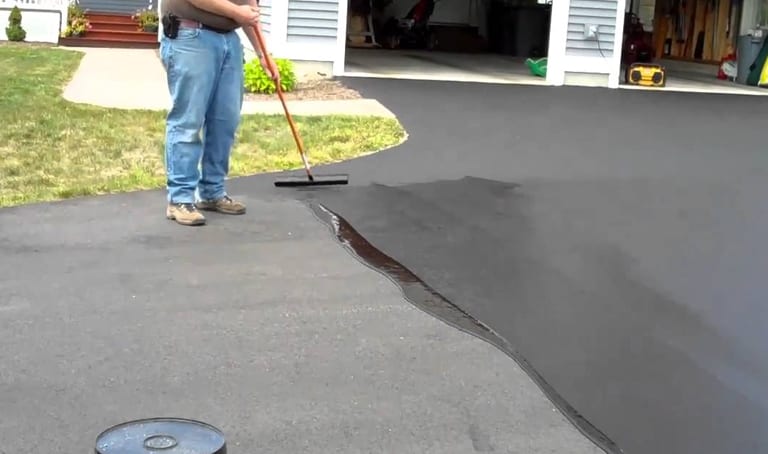Enhance Toughness: Hot Mix Asphalt Sealing for Angled Parking Frameworks
Enhance Toughness: Hot Mix Asphalt Sealing for Angled Parking Frameworks
Blog Article
Warm Mix Asphalt: A Sustainable Solution for Pavement
Hot Mix Asphalt (HMA) has actually arised as a leading lasting choice for sidewalk solutions, supplying a myriad of ingenious technologies and ecological benefits. As the demand for eco-friendly building and construction practices expands, discovering the subtleties of HMA's sustainability can provide important insights into the future of pavement services.
Environmental Advantages of Hot Mix Asphalt

In Addition, Warm Mix Asphalt aids to mitigate metropolitan warm island effects. Its dark color absorbs sunshine, lowering the quantity of warmth showed back into the atmosphere contrasted to lighter-colored pavements. This can decrease ambient temperatures in urban areas, lowering the need for cooling and eventually decreasing energy usage.
Additionally, Hot Mix Asphalt contributes to enhanced stormwater management. Its porous nature permits water to recharge and penetrate the pavement groundwater products, minimizing drainage and the risk of flooding. These ecological advantages make Hot Mix Asphalt a sustainable choice for paving roadways and highways.
Energy Efficiency in HMA Manufacturing
Is energy performance a crucial element in the manufacturing of Warm Mix Asphalt (HMA)? Definitely. Energy plays a substantial function in the manufacturing of HMA, influencing both cost and environmental sustainability. One key facet of energy effectiveness in HMA manufacturing is making use of warm mix asphalt (WMA) innovations (angled parking). WMA enables the mixing and positioning of asphalt at lower temperatures contrasted to conventional hot mix asphalt, causing minimized power consumption during manufacturing. This procedure not just reduces fuel use but additionally lowers greenhouse gas discharges, making it a more environmentally friendly option.
In addition, advancements in plant technologies have led to more energy-efficient HMA production procedures. Modern plants are made with attributes like recycled asphalt pavement (RAP) processing abilities, effective burner systems, and boosted insulation, all adding to energy savings. By maximizing power use in HMA production, the industry can reduce its carbon footprint while maintaining high-grade pavement materials. Power effectiveness is, as a result, a critical factor to consider in making certain the sustainability of Hot Mix Asphalt manufacturing.
Recyclability of Warm Mix Asphalt
The recyclability of Warm Mix Asphalt (HMA) is a pivotal element of its sustainability and long-lasting ecological influence. HMA is one of one of the most recycled products in the USA, with over 100 million loads of recovered asphalt sidewalk (RAP) being recycled yearly in new pavement construction. Reusing HMA provides several environmental advantages, such as minimizing the requirement for virgin materials, reducing energy intake during production, and lowering the amount of waste sent out to landfills.
The procedure of reusing HMA involves crushing the existing sidewalk, crushing it right into smaller pieces, and mixing it with brand-new aggregate and asphalt binder to create a recycled mix. This recycled mix can often carry out in addition to and even better than traditional HMA, while requiring fewer raw materials and creating reduced greenhouse gas emissions. By including RAP into brand-new pavement projects, road companies can conserve all-natural resources, minimize prices, and lessen the ecological footprint of road building angled parking and construction and maintenance activities. Generally, the recyclability of HMA plays a considerable role in advertising sustainable practices within the sidewalk industry.

Long-Term Performance of HMA
Asphalt sidewalks show resilience and resilience over a prolonged duration, reflecting the long-term performance of Warm Mix Asphalt (HMA) Furthermore, developments in HMA modern technology, such as the usage of polymer-modified binders and cozy mix asphalt, have even more boosted the longevity and long life of HMA pavements. By focusing on quality building and maintenance techniques, HMA continues to confirm itself as a lasting and cost-efficient solution for resilient sidewalk infrastructure.

HMA: Durability and Sustainability
Showing both toughness and sustainability, Warm Mix Asphalt (HMA) has ended up being a foundation in the building of durable sidewalk infrastructures - hot mix asphalt. HMA's durability originates from its capacity to stand up to heavy loads, harsh weather problems, and high web traffic quantities, making it a reliable choice for highways, highways, and flight terminal paths. The make-up of HMA, which normally consists of accumulations, binder, and filler, plays a crucial role in enhancing its longevity and resistance to damage
Additionally, HMA's sustainability hinges on its recyclability and energy-efficient production procedure. The ability to recycle redeemed asphalt sidewalk (RAP) in new HMA blends minimizes the demand for virgin materials and minimizes the environmental effect of pavement construction and upkeep. Additionally, the power performance of producing HMA exists in its reduced mixing temperature levels contrasted to other sidewalk products, bring about decreased energy usage and greenhouse gas exhausts.
Verdict
In final thought, warm mix asphalt (HMA) supplies a sustainable remedy for pavement with its ecologically pleasant characteristics. HMA's recyclability, power effectiveness in manufacturing, and lasting resilience make it an eco-friendly option for roadway construction.
HMA is one of the most recycled materials in the United States, with over 100 million lots of redeemed asphalt sidewalk (RAP) being recycled every year in new pavement building and construction.The procedure of recycling HMA includes grating the existing pavement, crushing it right into smaller sized items, and blending it with new aggregate and asphalt binder to develop a recycled mix.Asphalt pavements demonstrate durability and durability over an extensive duration, mirroring the long-lasting efficiency of Warm Mix Asphalt (HMA) Furthermore, improvements in HMA innovation, such as the use of polymer-modified binders and cozy mix asphalt, have actually even more enhanced the durability and durability of HMA sidewalks. The capacity to reuse reclaimed asphalt pavement (RAP) in new HMA blends decreases the demand for virgin products and lessens the environmental impact of pavement construction and maintenance.
Report this page